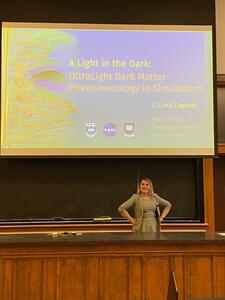
On April 1, 2022, Luna Zagorac successfully defended her thesis, “A Light in the Dark: UltraLight Dark matter Phenomenology in Simulations”. Advisors: Nikhil Padmanabhan (Yale University) and Richard Easther (University of Aukland).
Zagorac explained, “There are a lot of fascinating phenomena in the Universe which are invisible to even our most powerful telescopes; my research attempts to illuminate some of these. My Ph.D. work has mostly focused on dark matter—the problem of missing mass in the Universe—and one possible solution called UltraLight Dark Matter, or ULDM. Exploring a dark matter candidate such as ULDM hinges on writing and running code to simulate what the Universe might behave like if it were full of ULDM and comparing it to what we can study around us. In particular, I have used simulations to decompose clumps of dark matter called halos into a sum of their very fundamental shapes, called eigenstates. Studying these shapes has enabled me to compare simulations with calculations, predict how the halos will evolve in the future, and comment on how the halos will grow to sizes larger than the Milky Way. Finally, I’ve sketched out ways to continue this work and tie in ULDM eigenstates with my previous work on very old, very tiny black holes, which is also included in my thesis.”
In the Fall of 2022, Zagorac will start a position as a Postdoctoral Fellow at the Perimeter Institute of Theoretical Physics, where she plans to continue investigating mysterious phenomena in the Universe.
Thesis abstract: Of the outstanding problems in astronomy, the nature of dark matter is certainly one of the most mysterious. Containing five times more energy density than its luminous counterpart, dark matter has been shaping the large-scale structure of our Universe for billions of years. The expansion of accessible and accurate cosmological simulations has revolutionized how we visualize the imprint of dark matter in the structure of our Universe. In my Ph.D., I contributed to this revolution through the development and implementation of a new code, CHPLULTRA: a parallel, portable, and efficient tool for HPC simulations of a promising dark matter candidate, Fuzzy or UltraLight Dark Matter (ULDM). ULDM is a well-motivated axion-like dark matter candidate whose incredibly small mass results in naturally cored profiles, thus ameliorating many of the small-scale problems of cold dark matter (CDM) while maintaining the same robust large-scale results. When unperturbed, the lowest energy solution of the ULDM system is a spherical “soliton” structure with a known mass density profile. A ULDM dark matter halo is formed through collisions of these solitons and has two characteristic parts: a central soliton core, and an NFW “skirt” surrounding it. In order to investigate ULDM dynamics, I calculated the full spectrum of eigenstates for ULDM systems with approximately stationary potentials, thus allowing me to 1) link the qualitative behavior of soliton cores in ULDM simulations with superpositions of specific modes and 2) decompose CHPLULTRA simulations of ULDM halos into individual eigenstates. Using this formalism, I investigated the formation of halos through soliton collisions and the dependence of the final halo product on initial parameters. Crucially, this allowed me to explore how halo cores form and explain discrepancies in the literature surrounding the core-halo mass relation: a key prediction of ULDM. I was also able to comment on the composition of the halos’ skirts, including their qualitative behavior and eigenstate makeup, as a function of initial binary parameters. Finally, I sketched out some of the exciting future directions for understanding ULDM through the language of its eigenstates; these include combining my work on ULDM with my previous work on primordial black holes, which is included as part of this dissertation.
Photo from the defense
